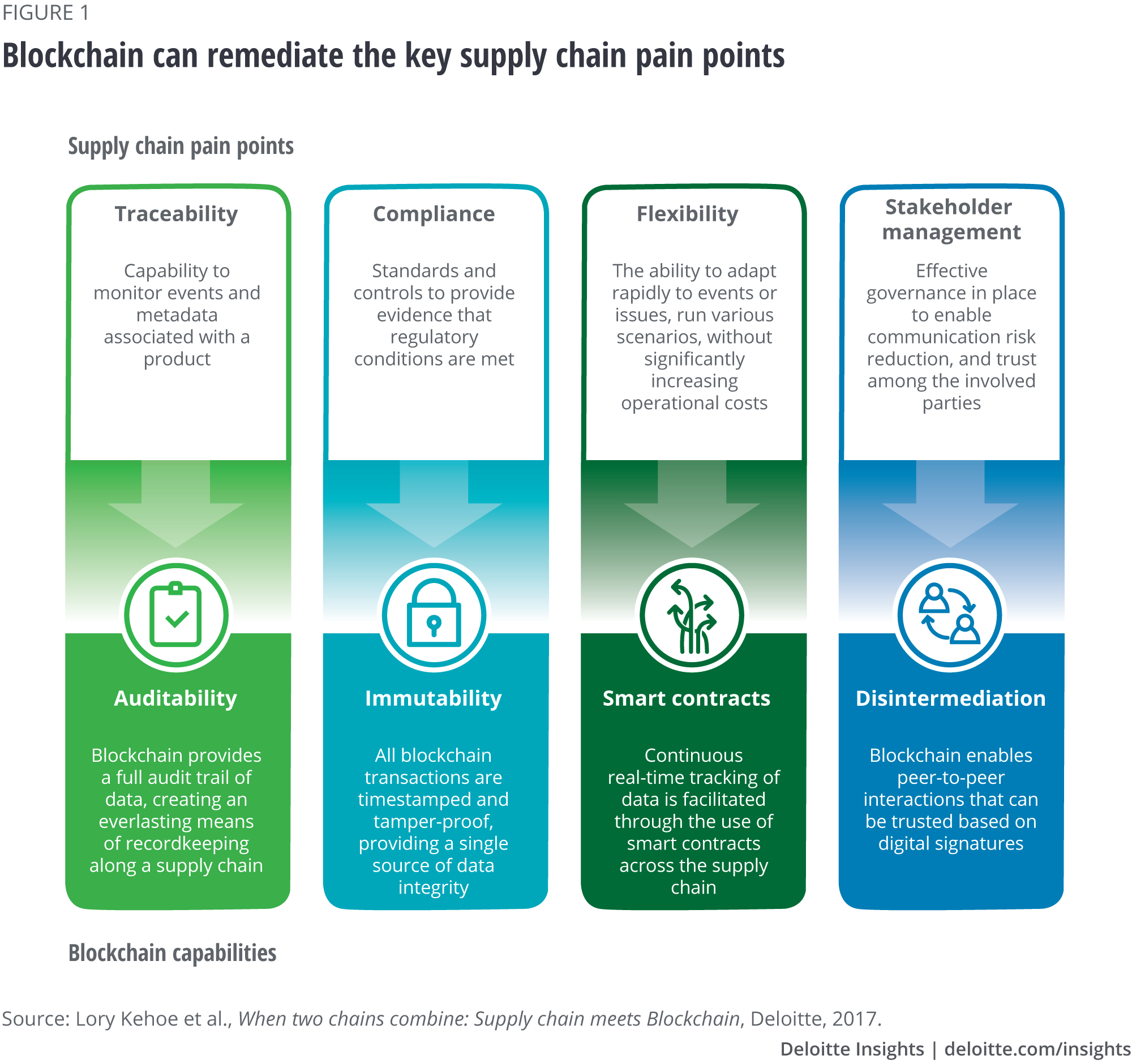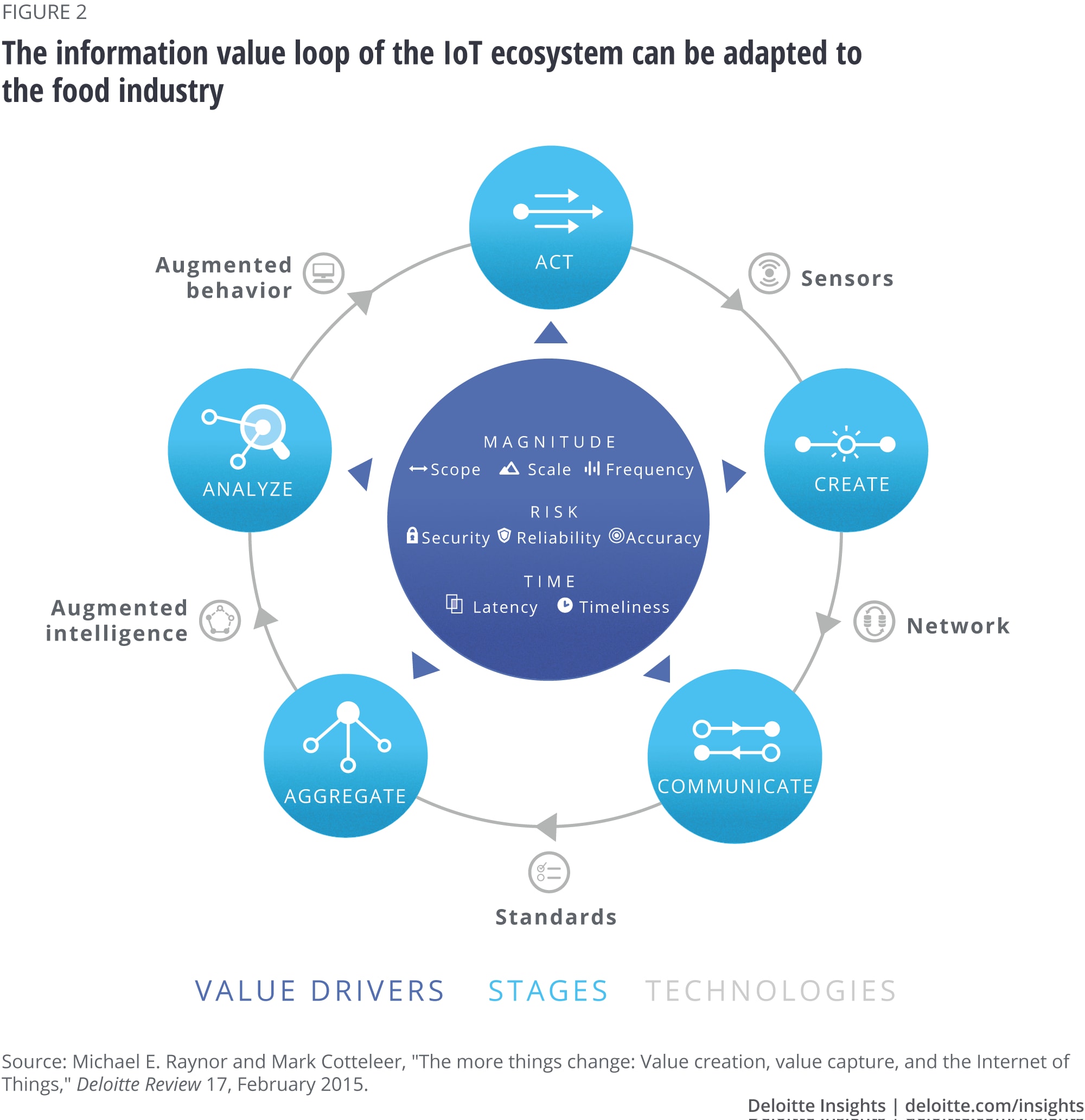
Adapting to landmark labeling laws in the food industry through blockchain and the Internet of Things
21 September 2018
New food-labeling laws and consumer concerns for food safety require the food industry to efficiently overhaul labeling practices. Blockchain and the Internet of Things can be useful tools for food companies and consumers alike.
Complying with new labeling laws with the help of technology
The food industry is undergoing regulatory change in relation to labeling requirements for the first time in nearly two decades. In 2016, the US Congress passed two major pieces of legislation: the National Bioengineered Food Disclosure Standard (NBFDS) and the Nutrition Facts Panel (NFP) Final Rule. Food companies have since been seeking clarifications on how to best interpret the new laws and adapt to greater regulatory transparency and consumer consciousness.
Learn More
Read more from the retail and consumer products collection
Subscribe to receive more consumer business content
Read more about the impact of Brexit on consumer goods companies
Read more about the potential impact of the trade policy on the consumer products industry
In an increasingly digitized world, blockchain and the Internet of Things (IoT)-based technologies can provide the food industry with opportunities to create and drive business value through traceability, driven by a connected supply chain, authenticity, targeted recall, and improving customer experience.1 While these technologies can be applied in the food industry in numerous ways, one potential application is to help food companies in the complex process of transitioning to the new labeling requirements.
A summary of labeling laws
Since the laws were passed in 2016, food companies and industry organizations have sought several clarifications from the US Department of Agriculture (USDA) and the US Food and Drug Administration (FDA). Clarifications regarding the NBFDS are expected in the second half of 2018, while the final interpretation of the NFP rule was issued recently.
The NBFDS addresses the mandatory labeling of genetically modified (GM) foods, sometimes referred to as genetically modified organisms (GMOs). In a recent clarification, the USDA has provided a list of products that must be disclosed, the proportion of GMO content that requires labeling, and the manner of such disclosures. Highlights of the new law are:
1) The preferred labeling term for GMOs is bioengineered (BE) food.2
2) A BE food product is identified based on whether the major ingredient is genetically engineered.
3) There should be a labeling symbol to represent BE food products or food products with BE ingredients.3
The NFP Final Rule outlines specifics for overall nutritional food labeling. The FDA believes that consumer awareness is essential as 1) it helps consumers understand what they are eating, and 2) it guides them toward eating more nutritious and healthy food.4 As such, in 2016, the FDA mandated changes to the NFP for food and beverage products to better highlight nutritional details. The NFP has wider influence as it outlines specifics for overall nutritional food labeling, and not just for BE food product labeling. In May 2018, more specific guidelines were provided regarding declarations of calories, sugars, daily reference values, percent daily values, the format of the nutrition facts label, and recordkeeping.
The complex process of adapting to new labeling laws
Since the passing of the new laws, many food companies have been grappling with the multifaceted process of modifying product information and messaging on their labels. But now, they should begin the process of adhering to the new laws in earnest. It is a complex process due to many factors—in addition to understanding the specifics of the new laws, there can be issues related to the volume of labels requiring change and coordinating the various incremental changes that have already been made, while also simultaneously managing costs and profitability.
The food industry finds itself in various states of compliance with the new requirements. Some companies have made strides in this area, while others have been waiting for clarifications—as of March 2018, only about 10% of food companies had adopted the new NFP requirements. Companies with annual sales of US$10 million or more should adhere to the requirements by January 1, 2020, while smaller organizations have time until January 1, 2021.5 The USDA is likely to provide clarifications on the NBFDS in the second half of 2018.
Concurrently, many food companies are feeling the pressure from consumers as well. Consumers in the United States and across the globe alike are increasingly concerned about how safe it is to consume GMOs and have questioned the information about GMOs that is provided on food labels. For example, in a survey done in 2015, 57% of American adults considered GMOs generally unsafe.6 Yet GMOs have been deemed safe by multiple renowned scientific organizations including the American Medical Association, the National Academy of Sciences, the FDA, the American Association for the Advancement of Science, the World Health Organization, and the Royal Society.7 Similarly, consumers express a strong desire for more detailed nutritional labeling. A Nielsen survey found that 67% of US consumers wanted to know everything that went into the food they bought. And 46% said food product claims—including words such as “organic,” “natural,” and “free from …”—have a direct influence on their purchases.8
Facilitating adaption of new labeling laws using blockchain
Blockchain solutions are in use in many industries such as pharmaceuticals. Similar solutions can be applied to the food industry as well (figure 1). The benefits of using the blockchain technology in the food industry can go beyond the traditional understanding of payment tracking, and include stock tracking, supply chain optimization, product replacement, etc. Blockchain solutions can allow companies to trace and track ingredients and products from the farm they were harvested in, all the way to the shelf in the grocery store. Through this process food companies can help uphold product authenticity. When applied to the transition to regulation-complaint labeling, blockchain can make it possible for companies to track products with compliant labeling and help ensure that the ingredients match what is indicated on the label.
Blockchain
Blockchain is a digital and distributed ledger of transactions, recorded and replicated in real time across a network of computers or nodes. Every transaction is cryptographically validated via a mechanism executed by the nodes before being permanently added as a “block” at the end of the “chain.” It is a centralized system, without the need for a central authority to approve transactions, which is why blockchain is sometimes referred to as a peer-to-peer trustless mechanism. Blockchain can be utilized broadly at three levels: for storing digital records, for exchanging digital assets, and for recording and executing smart contracts. Blockchain: A technical primer, a Deloitte primer on blockchain, gives a more detailed description of the technology and its uses.9
Traceability
In response to the growing need of food manufacturers to ensure the veracity of the ingredients they use as reflected on their labels, the global food traceability market is estimated to reach US$14.1 billion by 2019.10 This speaks to the growing need of manufacturers to ensure the authenticity of the ingredients they use. Blockchain can allow a seamless connection across all points of the supply chain, allowing food producers, sellers, and buyers to trace a product from farm to the consumer’s table. This paperless technology provides a full audit trail of data—one that cannot be tampered after it is fed into the system—creating an everlasting means of recordkeeping.11
Food manufacturers such as Cargill, Hershey, and Crunchies have begun using blockchain-based QR codes to provide the required details on farming and harvesting of their products (see case studies). Consumers can use their smartphones to scan the QR codes on food packages at the points of sale and receive a full and complete history of their food’s journey, ensuring the food they eat is exactly what’s listed on the label. Consumers can also track if the food or its ingredients contain any GM content, antibiotics, hormones, or any other undesirable chemicals, and alleviate their concerns about GMOs/BE food items, ingredient sourcing, etc. These codes can also help consumers verify claims such as grass-fed, natural, and organic.

Authenticity
A food manufacturer can use blockchain to prove the authenticity of products, eliminate the risk of counterfeiting, and help ensure consumer trust. Blockchain can make it possible for every touchpoint in a supply chain (be it a farmer, supplier, manufacturer, or shipper) to add a verifiable and immutable record in the form of a digital certificate to an item’s pedigree. This digital certificate can ensure that information from every touchpoint along the supply chain is documented and available in a transparent manner. Timestamping can also help in providing a unique trail for a food product and protect consumers from counterfeit goods. Food manufacturers can also trace stolen or missing products, and help prevent both sale and possession of stolen goods.12
For example, the World Wide Fund for Nature (WWF) and Viant have collaborated to use blockchain to tag tuna fish caught in Fiji and track its journey to Los Angeles. This allows groups like the WWF and Viant’s partners to verify that the harvest is from a sustainable fishery and to ensure authenticity of the product.13
Targeted recall
Blockchain-based solutions can facilitate a product recall should one be deemed necessary. This could occur if labeling requirements change or become redefined, or if companies have put out a label they thought was compliant at the time, but needs to change in the light of the clarifications issued. Targeted recall can reduce disruption to consumers as products can be pulled off the market quickly. For companies, it can mean potential savings in recall costs as well as faster and accurate recalls. Further, blockchain-based applications can track the status of the recall and help in regulatory reporting.14
An example of where a blockchain-enabled application could have helped is the case of the romaine lettuce-centered E. coli outbreak in the United States during the 2017 holiday season. Authorities were unable to trace the exact source of the outbreak that directly threatened millions of people. Sales of romaine lettuce fell by 45 percent in May 2018. Yet a similar outbreak happened in June 2018. A blockchain-enabled application could have helped contain the outbreak by quickly identifying the contaminated consignments and possibly even the point of contamination. Such crises can have a negative effect on consumer confidence and businesses,15 but they can be averted by using the appropriate technological tool.
Customer experience
Many consumers are interested in knowing how their food and ingredients are farmed and harvested, and whether they are free from hormones, antibiotics, and pesticides.16 Smart, QR-code-enabled labels providing accurate information would likely win consumer confidence. Knowing that companies will be able to recall contaminated or spurious products if required can help build consumer trust. Providing access to this level of product information can help food companies positively differentiate from competitors, enhance customer experience, build brand loyalty, and thereby potentially increase their market share.
Case studies
These case studies illustrate the successful application of blockchain in the food industry and point to ways to potentially apply blockchain in the transition to compliant labeling.
Tracing Cargill’s turkeys
During the 2017 Thanksgiving holiday season in the United States, Cargill tested its blockchain technology to track a key product—the Thanksgiving turkey. Cargill allowed consumers to trace their individual Thanksgiving turkey from the farm it was raised on to the store where it was purchased. A QR code applied to Cargill’s Honeysuckle White brand of turkeys triggered a text or code that consumers could feed in HoneysuckleWhite.com to access the farm’s location by state and country, view photos of the farm, and read a message from the farmer. Even though the pilot effort was limited to four farms in Texas, it made Cargill’s Honeysuckle White brand the first major turkey brand to do so.17 Consumers demonstrated strong interest in knowing whether their meat was antibiotic-free, hormone-free, grass-fed, natural, and organic.18
Hershey’s investment in transparency
In 2016, Hershey began exploring the use of blockchain to drive product transparency. The company participated in the SmartLabel program of the Grocery Manufacturers Association and added barcodes to its packaging that consumers could scan with their smartphones. Upon scanning the code, the consumers got information about the ingredients, nutrients, and allergens in a product. Enthused by the success in this area, Hershey partnered with Sourcemap in 2017 to develop an interactive mapping tool that helps consumers visualize and trace the agricultural ingredients to where they were grown. With this technology, consumers can visit Hershey’s website and see how ingredients of a product are farmed and harvested. For example, they can discover how cocoa beans are harvested in Ghana and learn about cooperatives supported by Hershey in Cote d’Ivoire.19
Crunchies’ platform for traceability
Crunchies, a freeze-dried-fruit company, introduced a blockchain-based traceability platform for its products in 2017, allowing consumers to identify the origin of its products. Crunchies has a global supply chain that sources strawberries from three different countries, and was keen to illustrate this fact to its consumers. Crunchies deployed blockchain-enabled applications to develop a traceability button on its website, allowing consumers to enter the lot code on a packet to find the source of the product and explain why a particular product was sourced from a given country.20 Providing this information in a transparent manner plays a large role in positively differentiating the products of Crunchies in the market.21
Using IoT applications in food retail
There are many opportunities for food companies to work in concert with retailers to integrate data across the entire supply chain ecosystem. After products leave the manufacturer’s watchful eye, several other IoT applications can help retailers communicate information provided by farmers, food manufacturers, distributors, and consumers at the point of sale, thus maximizing the use of blockchain capabilities (figure 2).
Beacons, geofencing, and near-field communication devices
Beacons, geofencing, and near-field communication are technologies used to identify a person or object in an area wirelessly in order to transfer data. They have been used by retailers since 2013. In retail, such devices detect consumers’ smartphones and can send product and ingredient information to the phones when they are in close proximity of a given product,22 notifying consumers of special offers and incentives as they pass by or visit a retail establishment.
Smart kiosks
Many retailers deploy customized kiosks that provide detailed content and ingredient information about food products on the consumer’s request. These kiosks are often positioned close to specific products, and can be programmed to display detailed information about the ingredients, nutritional content, source, etc.
Sensors
Many retailers are also using sensor-based technology, where signages having sensors transfer information about a product when a customer’s smartphone is placed beside such signages.

New labeling laws and blockchain technologies signal a new era of transparency for both food companies and consumers
Implementation of new labeling laws facilitated by blockchain and IoT technologies will likely provide food companies full transparency regarding the journey their products make from the farm to the consumer. Consumers can gain access to the critical information they need to make more informed food choices. In the end, food manufacturers and retailers will likely benefit from knowledgeable consumers who come to know and place their trust in food products. Several initial steps that can help facilitate the adoption of blockchain technologies include the following.
Tagging and labeling food ingredients across the supply chain
Tagging and labeling of all ingredients and product forms across the supply chain can help food companies in tracking and reporting to the smallest ingredient. This elaborate task can be simplified with the use of blockchain.
Transitioning to technology-based recordkeeping
Despite making rapid progress in digitization across the supply chain, paper-based and manual processes of documentation can still be commonplace. Manual processes can make decision-making complicated, slow, and subject to error, whereas technology-based systems can simplify processes and lead to greater efficiencies. That blockchain is a paperless technology helps ensure no loss of data and information.
Staying vigilant to changes in labeling regulation
Food companies will likely benefit by proactively seeking and evaluating clarifications as they are announced and working with industry associations if further clarifications are needed. By moving along the curve of regulatory change, they will likely position themselves better for the change in the consumer products marketplace itself.
Blockchain and IoT-based technologies can enable the food industry to seamlessly transition to full compliance with the new labeling requirements. There is likely an exciting future ahead for other blockchain applications, as companies continue to explore and develop new use cases and work toward overcoming barriers to adaption, such as budget approvals, leadership buy-ins, solutions’ security, prioritizing other internal technology investments, and determining and quantifying the cost-benefit play of use cases. Overall, technology can give food companies the ability to capture and communicate information as well as trace products and ingredients across the food supply chain from farmers, food manufacturers, distributors, retailers, and consumers at the point of purchase. It can also enable food companies to provide the transparency of product ingredients that is the intent of the new labeling laws.




